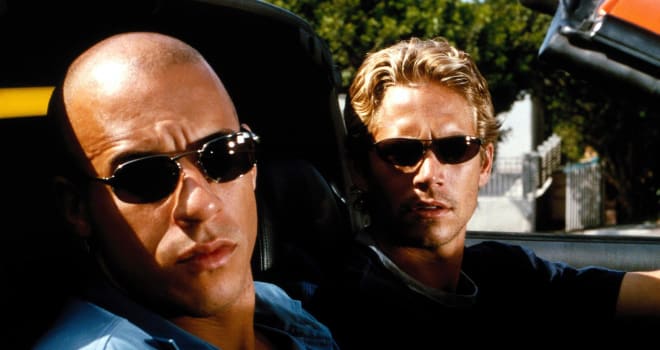 When it came out 15 years ago, on June 22, 2001, "The Fast and the Furious" seemed like just a 1950s exploitation movie with a bigger budget. Little did anyone imagine that the drag-race drama would turn into an enormous franchise that has earned $3.9 billion to date and spawned six sequels, with at least three more on the way.
When it came out 15 years ago, on June 22, 2001, "The Fast and the Furious" seemed like just a 1950s exploitation movie with a bigger budget. Little did anyone imagine that the drag-race drama would turn into an enormous franchise that has earned $3.9 billion to date and spawned six sequels, with at least three more on the way.As popular as the first "Fast" was -- it earned $145 million in North America and a total of $207 million worldwide -- there's plenty you may not know about how the film came to be. Here are a few tidbits of behind-the-scenes trivia, doled out a quarter-mile at a time.
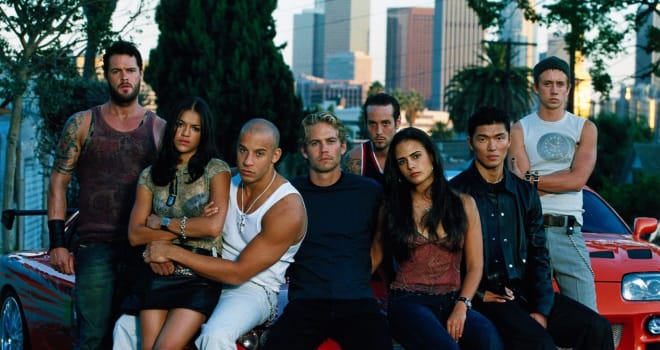 1. In 1998, reporter Ken Li began writing a series of articles about 30-year-old Dominican street racer Rafael Estevez, first in the New York Daily News, then in Vibe magazine. Director Rob Cohen claimed he was inspired to make the film by reading one of those articles, entitled "Racer X" (for which Universal bought the film rights and adapted into the "Fast" screenplay), as well as by attending an actual illegal street race.
1. In 1998, reporter Ken Li began writing a series of articles about 30-year-old Dominican street racer Rafael Estevez, first in the New York Daily News, then in Vibe magazine. Director Rob Cohen claimed he was inspired to make the film by reading one of those articles, entitled "Racer X" (for which Universal bought the film rights and adapted into the "Fast" screenplay), as well as by attending an actual illegal street race.2. The title was licensed from B-movie legend Roger Corman. His 1955 film, "The Fast and the Furious," was about a wrongly-convicted man who escapes from prison and takes up with a gang of illegal street racers. Of course, Corman produced his movie for just $66,000, while Cohen's cost $38 million.
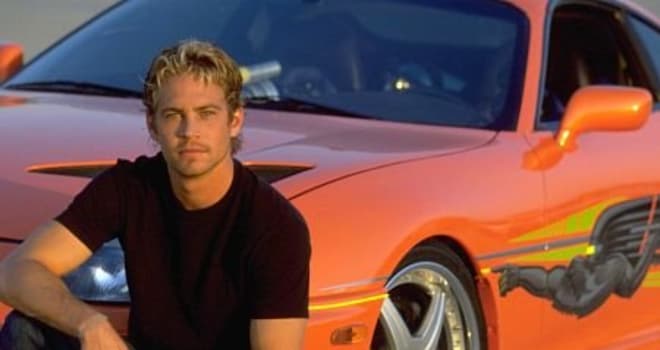 3. While making "The Skulls" for Cohen and producer Neal H. Moritz, Paul Walker mentioned that he'd love to play an undercover cop one day. He didn't know at the time that Cohen and Moritz were developing just such a project.
3. While making "The Skulls" for Cohen and producer Neal H. Moritz, Paul Walker mentioned that he'd love to play an undercover cop one day. He didn't know at the time that Cohen and Moritz were developing just such a project.4. In his college days, Vin Diesel recalled, he had a Suzuki GSX-R sport bike that he would tear along on the highways of Queens, N.Y. But by the time he first played Dominic Toretto in "Fast" at age 33, he admitted, "I'm an SUV kind of guy."
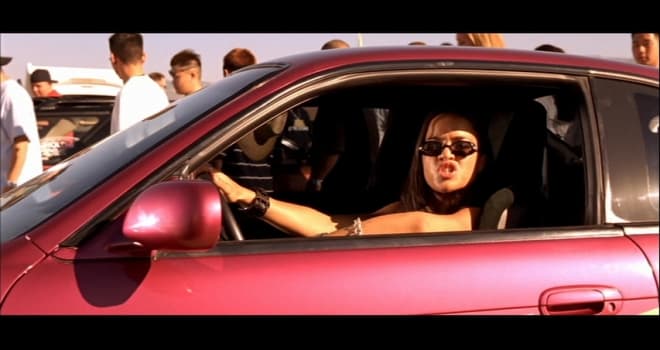 5. Michelle Rodriguez's role of Letty (above) wasn't part of the original script, but the filmmakers created it for her after seeing her breakthrough performance in the indie boxing drama "Girlfight."
5. Michelle Rodriguez's role of Letty (above) wasn't part of the original script, but the filmmakers created it for her after seeing her breakthrough performance in the indie boxing drama "Girlfight."6. Neither Jersey girl Rodriguez nor Manhattan-raised Jordana Brewster (Mia) had much driving experience before they made the film; in fact, Brewster (then 20) didn't have a driver's license or even know how to drive. Both actresses had to learn some stunt-driving moves, including slides and sideways turns, for the movie. By the end of the shoot, newly-minted car enthusiast Rodriguez was complaining of the filmmakers, "They wouldn't let us drive faster than 80 miles per hour!"
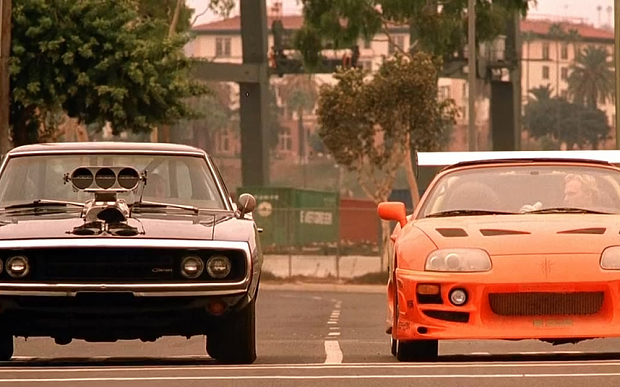 7. Seen in the movie are some 150 actual street racers, along with their custom cars. They were easy to recruit, recalled transportation coordinator David Marder. "Every one of these kids have monitors hooked up in their cars, where they play video games and use the Internet," he said. "We just put out the word, and they appeared!"
7. Seen in the movie are some 150 actual street racers, along with their custom cars. They were easy to recruit, recalled transportation coordinator David Marder. "Every one of these kids have monitors hooked up in their cars, where they play video games and use the Internet," he said. "We just put out the word, and they appeared!"8. The unique circular Beverly Hills house that the police use as their sting headquarters is said in the film to be the home Eddie Fisher built for Elizabeth Taylor. Sadly, that's not true; it wasn't built until 1963, when Taylor had left Fisher for Richard Burton. Less juicy trivia: it's the same house where Walter Matthau's screenwriter character lived in the 2000 Nora Ephron movie "Hanging Up."
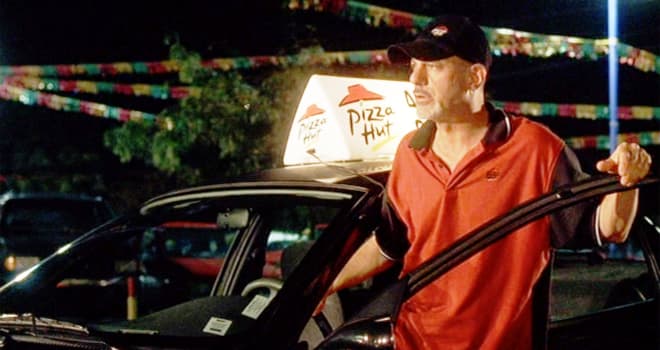 9. Moritz and Cohen both have cameos in the film. That's Moritz as the driver of the black Ferrari who races Brian (Walker). And that's Cohen (above) as the pizza delivery man blocked by the first race.
9. Moritz and Cohen both have cameos in the film. That's Moritz as the driver of the black Ferrari who races Brian (Walker). And that's Cohen (above) as the pizza delivery man blocked by the first race.10. Today, Rafael Estevez, the inspiration for the whole franchise, runs a garage in Queens. Journalist Li says Estevez eventually got compensation from Universal for his role as the franchise's catalyst.
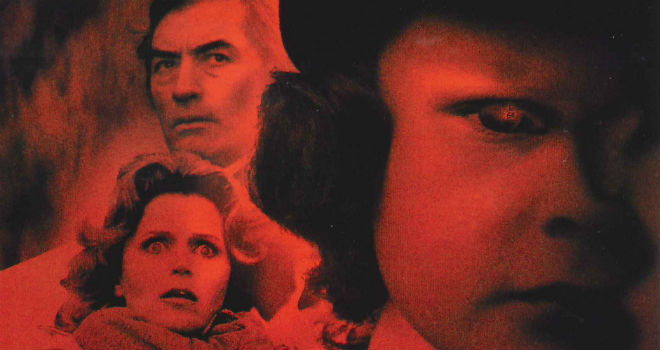 Four decades later, we're still haunted by the chilling thousand-yard stare of little
Four decades later, we're still haunted by the chilling thousand-yard stare of little 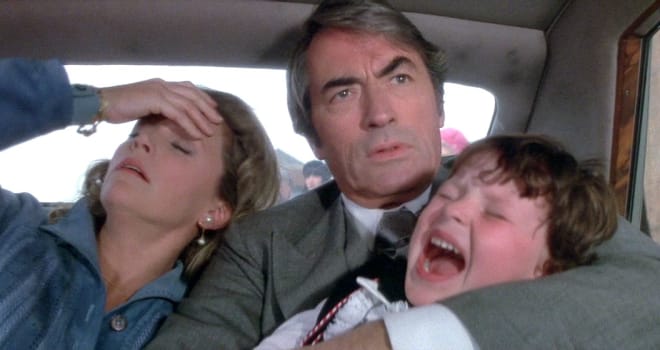 1. A lot of "Omen" viewers have thought that rhyming-prophecy quotation actually comes from the Bible. It does not; screenwriter
1. A lot of "Omen" viewers have thought that rhyming-prophecy quotation actually comes from the Bible. It does not; screenwriter 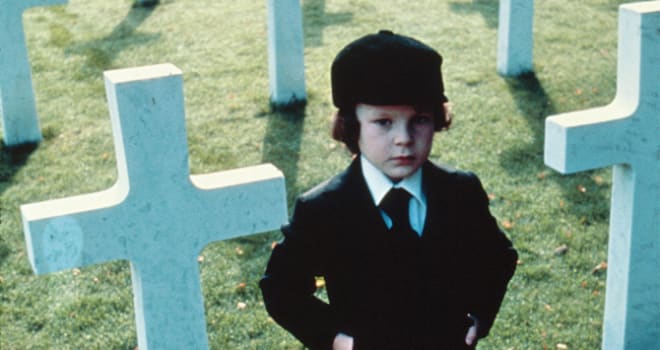 3. Four-year-old Harvey Stephens (above) won the role of Damien during a group audition, when director
3. Four-year-old Harvey Stephens (above) won the role of Damien during a group audition, when director  5. The baboon attack on the car in the zoo sequence was accomplished by placing a baboon in the car with Lee Remick. At first, zookeepers used a baby baboon, but the other baboons didn't seem to care. Then they put the alpha baboon in the car, and the rest of them went ape. The terror on Remick's face wasn't acting.
5. The baboon attack on the car in the zoo sequence was accomplished by placing a baboon in the car with Lee Remick. At first, zookeepers used a baby baboon, but the other baboons didn't seem to care. Then they put the alpha baboon in the car, and the rest of them went ape. The terror on Remick's face wasn't acting.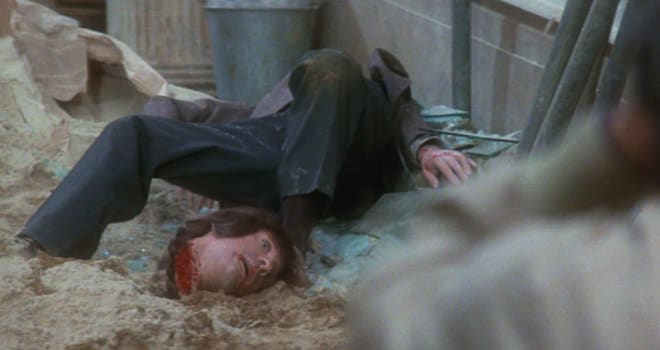 9. Warner was asked once what became of the prop severed head (pictured) of his ill-fated "Omen" character. He quipped, "I lost it in the divorce."
9. Warner was asked once what became of the prop severed head (pictured) of his ill-fated "Omen" character. He quipped, "I lost it in the divorce." Losing
Losing  1. Monty Python's
1. Monty Python's  2. Among the teen actresses who auditioned for the lead role of Sarah were
2. Among the teen actresses who auditioned for the lead role of Sarah were  3. Jareth was supposed to be just another puppet until Henson decided the role would work better with a charismatic rock star in the part. Among the names tossed around were
3. Jareth was supposed to be just another puppet until Henson decided the role would work better with a charismatic rock star in the part. Among the names tossed around were  4. "Labyrinth" wears its influences, which come from all over, on its sleeve.
4. "Labyrinth" wears its influences, which come from all over, on its sleeve.  6. The film's choreography -- in this case, acting and movement coaching for the puppeteers -- is credited to Cheryl McFadden. A year later, she became famous as
6. The film's choreography -- in this case, acting and movement coaching for the puppeteers -- is credited to Cheryl McFadden. A year later, she became famous as  7. The entire forest set was built indoors, on a British soundstage. It involved 40,000 sprays of fake leaves, 850 pounds of real dried leaves, 120 truckloads of tree branches, 1,200 patches of sod, 133 bags of lichen, and 35 mossy bundles of "old man's beard."
7. The entire forest set was built indoors, on a British soundstage. It involved 40,000 sprays of fake leaves, 850 pounds of real dried leaves, 120 truckloads of tree branches, 1,200 patches of sod, 133 bags of lichen, and 35 mossy bundles of "old man's beard." 8. Shortly after Bowie's death in January 2016, news came out that the Jim Henson company was preparing a reboot of "Labyrinth," to be scripted by "
8. Shortly after Bowie's death in January 2016, news came out that the Jim Henson company was preparing a reboot of "Labyrinth," to be scripted by " 9. Sarah's kidnapped baby brother, Toby, was played by
9. Sarah's kidnapped baby brother, Toby, was played by  10. "Labyrinth" cost a reported $25 million to make but returned only $12.9 million at the North American box office. Brian Henson has said the movie's box office failure depressed his father, but he did live long enough to see the film become a cult success on home video before his death in 1990.
10. "Labyrinth" cost a reported $25 million to make but returned only $12.9 million at the North American box office. Brian Henson has said the movie's box office failure depressed his father, but he did live long enough to see the film become a cult success on home video before his death in 1990. It's been 10 years since "
It's been 10 years since "


 It's hard to believe it's been 25 years since "
It's hard to believe it's been 25 years since " 1.
1.  2. Cameron also reportedly mulled over the idea of casting "
2. Cameron also reportedly mulled over the idea of casting " 3. Because "Hasta la vista, baby" doesn't have quite the same impact when the entire film is dubbed in Spanish, the Spanish version of "Terminator 2" changed that line to say "Sayonara, baby."
3. Because "Hasta la vista, baby" doesn't have quite the same impact when the entire film is dubbed in Spanish, the Spanish version of "Terminator 2" changed that line to say "Sayonara, baby." 4. Cameron revealed that the biker bar sequence was filmed across the street from where the infamous LAPD beating of Rodney King took place. Apparently the filming was taking place while the beating was happening.
4. Cameron revealed that the biker bar sequence was filmed across the street from where the infamous LAPD beating of Rodney King took place. Apparently the filming was taking place while the beating was happening. 5. During the filming of that biker bar scene, a random passerby wandered onto set confused as to why Schwarzenegger was walking around wearing nothing but Bermuda shorts. The actor nonchalantly informed her that it was male stripper night at the bar.
5. During the filming of that biker bar scene, a random passerby wandered onto set confused as to why Schwarzenegger was walking around wearing nothing but Bermuda shorts. The actor nonchalantly informed her that it was male stripper night at the bar. 6.
6.  7. As effects-driven as this movie was, Cameron relied on twin actors to save time and money whenever scenes called for body doubles. In the scene where the T-1000 is disguised as Sarah Connor,
7. As effects-driven as this movie was, Cameron relied on twin actors to save time and money whenever scenes called for body doubles. In the scene where the T-1000 is disguised as Sarah Connor,  8. When our heroes are refueling their car after fleeing into the desert, a gas pump can be seen sporting the logo for Benthic Petroleum, the fictional company that owned the oil rig in "
8. When our heroes are refueling their car after fleeing into the desert, a gas pump can be seen sporting the logo for Benthic Petroleum, the fictional company that owned the oil rig in " 9. If the mini-gun Schwarzenegger's T-800 wields during the Cyberdyne shootout looks familiar, that's because the exact same prop gun was also used by Jesse Ventura's character in 1987's "
9. If the mini-gun Schwarzenegger's T-800 wields during the Cyberdyne shootout looks familiar, that's because the exact same prop gun was also used by Jesse Ventura's character in 1987's " 10. While the original "Terminator" was a decent box office success in 1984, this sequel managed to top that gross in its first two days of release. The film went on to become the highest-grossing movie of 1991. (At the time, it was also the most expensive movie ever made.)
10. While the original "Terminator" was a decent box office success in 1984, this sequel managed to top that gross in its first two days of release. The film went on to become the highest-grossing movie of 1991. (At the time, it was also the most expensive movie ever made.) 11. The "Terminator 2" Blu-ray includes an alternate ending that showcases the happy, Terminator-free future that the Connors created by defeating Skynet. But as the sequels have shown us, that future never came to pass.
11. The "Terminator 2" Blu-ray includes an alternate ending that showcases the happy, Terminator-free future that the Connors created by defeating Skynet. But as the sequels have shown us, that future never came to pass. It's been 15 years since
It's been 15 years since  1. "Legally Blonde" started as a series of letters home from Stanford Law School, written by first-year student
1. "Legally Blonde" started as a series of letters home from Stanford Law School, written by first-year student  3. The studio had other stars in mind for Elle, including
3. The studio had other stars in mind for Elle, including  4. For Vivian, Elle's romantic rival, the filmmakers wanted
4. For Vivian, Elle's romantic rival, the filmmakers wanted  6. It took a lot of effort to style Witherspoon for the film. Over the course of "Legally Blonde," she wears no fewer than 40 different hairdos. (Luketic referred to her ever-changing coiffure as "the hair that ate Hollywood.") Not to mention all of those pink outfits, which, thanks to a clause in her contract, Witherspoon got to keep after the shoot wrapped.
6. It took a lot of effort to style Witherspoon for the film. Over the course of "Legally Blonde," she wears no fewer than 40 different hairdos. (Luketic referred to her ever-changing coiffure as "the hair that ate Hollywood.") Not to mention all of those pink outfits, which, thanks to a clause in her contract, Witherspoon got to keep after the shoot wrapped. 8. The movie initially ended after Elle's courtroom victory, but test audiences wanted more, so the filmmakers planned an epilogue showing Elle's graduation from law school. Witherspoon was already in London making "
8. The movie initially ended after Elle's courtroom victory, but test audiences wanted more, so the filmmakers planned an epilogue showing Elle's graduation from law school. Witherspoon was already in London making " 10. After the sequel, 2003's "
10. After the sequel, 2003's " Upon its release 25 years ago, on July 12, 1991, "
Upon its release 25 years ago, on July 12, 1991, " 1. Singleton (above) was a film student at USC when he landed his first showbiz job as a production assistant on "
1. Singleton (above) was a film student at USC when he landed his first showbiz job as a production assistant on " 3. Working as a script reader at Columbia Pictures, Singleton got his own script passed all the way to studio chief Frank Price. He was offered $100,000 for it on the condition that he let someone with more experience direct it, but he refused to sell "Boyz" unless he could direct his own screenplay.
3. Working as a script reader at Columbia Pictures, Singleton got his own script passed all the way to studio chief Frank Price. He was offered $100,000 for it on the condition that he let someone with more experience direct it, but he refused to sell "Boyz" unless he could direct his own screenplay. 7. Long was nervous about shooting her sex scene with Gooding, never having shot one before. He tried to calm her by picking his toenails and acting silly, but the tactic backfired. "Do you honestly think that is helping?" Long told her co-star. "It's making me want to throw up."
7. Long was nervous about shooting her sex scene with Gooding, never having shot one before. He tried to calm her by picking his toenails and acting silly, but the tactic backfired. "Do you honestly think that is helping?" Long told her co-star. "It's making me want to throw up." 9. Violence broke out at screenings of "Boyz" around the country, with one fatality and 33 moviegoers injured. Some observers blamed the movie's gang content for the gunplay, even though "Boyz" was explicitly anti-violence. Singleton blamed the strife on the same social pathologies that the movie condemned -- street codes of vengeance and the scarcity of strong paternal role models in the community.
9. Violence broke out at screenings of "Boyz" around the country, with one fatality and 33 moviegoers injured. Some observers blamed the movie's gang content for the gunplay, even though "Boyz" was explicitly anti-violence. Singleton blamed the strife on the same social pathologies that the movie condemned -- street codes of vengeance and the scarcity of strong paternal role models in the community. As terrifying as 1979's "
As terrifying as 1979's " 1. James Cameron (above) received two job offers on the same day: to write the screenplay for "
1. James Cameron (above) received two job offers on the same day: to write the screenplay for " 2. Weaver almost didn't make it into the movie. Cameron wrote the script around Ripley without knowing that 20th Century Fox didn't have a deal in place with the actress. The studio ordered him to write her out of the picture, but he threatened to walk instead.
2. Weaver almost didn't make it into the movie. Cameron wrote the script around Ripley without knowing that 20th Century Fox didn't have a deal in place with the actress. The studio ordered him to write her out of the picture, but he threatened to walk instead. 3. The filmmakers didn't want the girl playing Newt to seem too polished and professional, so their casting search led them to untried nine-year-old
3. The filmmakers didn't want the girl playing Newt to seem too polished and professional, so their casting search led them to untried nine-year-old  4.
4.  5. Shooting at England's Pinewood Studios, Cameron and producer
5. Shooting at England's Pinewood Studios, Cameron and producer  6.
6.  7. Weaver, too, was no firearm expert; in fact, she didn't think Ripley should wield a gun at all. But Cameron took her to a firing range, and she soon decided that shooting was fun. "Another liberal bites the dust," Cameron joked on the DVD commentary.
7. Weaver, too, was no firearm expert; in fact, she didn't think Ripley should wield a gun at all. But Cameron took her to a firing range, and she soon decided that shooting was fun. "Another liberal bites the dust," Cameron joked on the DVD commentary. 8. The alien queen was an elaborate puppet created in the workshop of legendary monster designer
8. The alien queen was an elaborate puppet created in the workshop of legendary monster designer  9. "Aliens" cost just $18.5 million to make, which seems like an absurdly low figure by the standards of today's summer blockbuster sequel filmmaking. (Nowadays, it would cost 10 times that.) It returned $85 million in North America (and a total of $131 million worldwide) to become the seventh highest-grossing film of 1986.
9. "Aliens" cost just $18.5 million to make, which seems like an absurdly low figure by the standards of today's summer blockbuster sequel filmmaking. (Nowadays, it would cost 10 times that.) It returned $85 million in North America (and a total of $131 million worldwide) to become the seventh highest-grossing film of 1986. 10. The movie was nominated for seven Oscars, including Best Actress for Weaver (a rare honor from an Academy that usually ignores performances in sci-fi and fantasy features), Best Score (even though composer
10. The movie was nominated for seven Oscars, including Best Actress for Weaver (a rare honor from an Academy that usually ignores performances in sci-fi and fantasy features), Best Score (even though composer  11. In 2011,
11. In 2011,  Hard to imagine, but when it was released 15 years ago (on July 27, 2001), "
Hard to imagine, but when it was released 15 years ago (on July 27, 2001), " 1. Wain and co-screenwriter/star
1. Wain and co-screenwriter/star  3. Many of the cast members --
3. Many of the cast members --  5. Garofalo was surprised to see, inscribed on a plaque on a bunk, the name of her "
5. Garofalo was surprised to see, inscribed on a plaque on a bunk, the name of her " 7. The film's most elaborate prop, the falling Skylab capsule, took five days to build. It was made largely of wood and PVC pipe, and it weighed just under 500 pounds.
7. The film's most elaborate prop, the falling Skylab capsule, took five days to build. It was made largely of wood and PVC pipe, and it weighed just under 500 pounds. 9. Months later, USA Films approached Wain with what he considered an insulting offer of $100,000 for the distribution rights, but he still said yes. USA barely released the movie (it never played in more than 12 theaters nationwide), which grossed just $295,000. Rudd has said he never saw a dime from the film.
9. Months later, USA Films approached Wain with what he considered an insulting offer of $100,000 for the distribution rights, but he still said yes. USA barely released the movie (it never played in more than 12 theaters nationwide), which grossed just $295,000. Rudd has said he never saw a dime from the film. 11. We're getting
11. We're getting  In some ways, Disney's animated "
In some ways, Disney's animated " 1.
1.  3. Disney hired visionary "Brave New World" novelist Aldous Huxley to write an "Alice" screenplay, but he found Huxley's draft too literal. He soon decided the only way to adapt Lewis Carroll's books was to make the feature entirely animated and not be too faithful to the nearly plotless tales. Inspired by concept art of Wonderland settings that he'd solicited from Mary Blair, Disney decided to take the project in a more whimsical, comic direction.
3. Disney hired visionary "Brave New World" novelist Aldous Huxley to write an "Alice" screenplay, but he found Huxley's draft too literal. He soon decided the only way to adapt Lewis Carroll's books was to make the feature entirely animated and not be too faithful to the nearly plotless tales. Inspired by concept art of Wonderland settings that he'd solicited from Mary Blair, Disney decided to take the project in a more whimsical, comic direction. 5. Sammy Fain's title song became a jazz hit for
5. Sammy Fain's title song became a jazz hit for  7. Others in the cast had less familiar names, though Disney fans would recognize their voices as they recurred in other Disney projects.
7. Others in the cast had less familiar names, though Disney fans would recognize their voices as they recurred in other Disney projects.  9. "Alice" cost $3 million to make, during a production that spanned five years, three directors, 13 credited writers, 750 artists, 800 gallons of paint,1,000 watercolor hues, and 350,000 drawings and paintings. It earned back just $2.4 million.
9. "Alice" cost $3 million to make, during a production that spanned five years, three directors, 13 credited writers, 750 artists, 800 gallons of paint,1,000 watercolor hues, and 350,000 drawings and paintings. It earned back just $2.4 million. 12. In the 1960s, "Alice" (like "
12. In the 1960s, "Alice" (like " As "
As " Sure,
Sure,  1. Lucas had dreamed of making a movie about Marvel's intergalactic duck ever since his days working on "
1. Lucas had dreamed of making a movie about Marvel's intergalactic duck ever since his days working on " 3. The puppet's brain -- the unit that made his eyes and facial muscles move and his bill open and close -- was actually underneath Howard's tail feathers. It took many months to design Howard, in no small part because the filmmakers had to have several meetings with Disney lawyers to make sure Howard didn't resemble Donald Duck too closely.
3. The puppet's brain -- the unit that made his eyes and facial muscles move and his bill open and close -- was actually underneath Howard's tail feathers. It took many months to design Howard, in no small part because the filmmakers had to have several meetings with Disney lawyers to make sure Howard didn't resemble Donald Duck too closely. 5. Several top comedian's were considered to provide Howard's voice, including
5. Several top comedian's were considered to provide Howard's voice, including  7. To play rock singer Beverly, the filmmakers auditioned many actresses, including actual rock singer
7. To play rock singer Beverly, the filmmakers auditioned many actresses, including actual rock singer  9. The love scene (above) involving Howard and Beverly is probably what creeped out viewers the most -- Prentice, too (and his guardian), which is why Gale performed the scene. But Thompson thought it was no big deal.
9. The love scene (above) involving Howard and Beverly is probably what creeped out viewers the most -- Prentice, too (and his guardian), which is why Gale performed the scene. But Thompson thought it was no big deal. 11. Though Universal wanted a family audience, its marketing campaign for "Howard" suggested otherwise. A promotional deal with Budweiser featured the duck in magazine ads that claimed Bud was the beer-chugging bird's favorite brew. There was also a 1-900 number you could call and be insulted by Zien (as Howard) for $1.99 a minute.
11. Though Universal wanted a family audience, its marketing campaign for "Howard" suggested otherwise. A promotional deal with Budweiser featured the duck in magazine ads that claimed Bud was the beer-chugging bird's favorite brew. There was also a 1-900 number you could call and be insulted by Zien (as Howard) for $1.99 a minute. 14. The movie's cult fanbase and the surprise cameo by Howard (above) at the end of 2014's "Guardians of the Galaxy" -- along with the CGI that made "Guardians"' Howard-like Rocket Raccoon a believable character -- made a lot of fans think a new "Howard" movie was imminent. Alas, according to
14. The movie's cult fanbase and the surprise cameo by Howard (above) at the end of 2014's "Guardians of the Galaxy" -- along with the CGI that made "Guardians"' Howard-like Rocket Raccoon a believable character -- made a lot of fans think a new "Howard" movie was imminent. Alas, according to 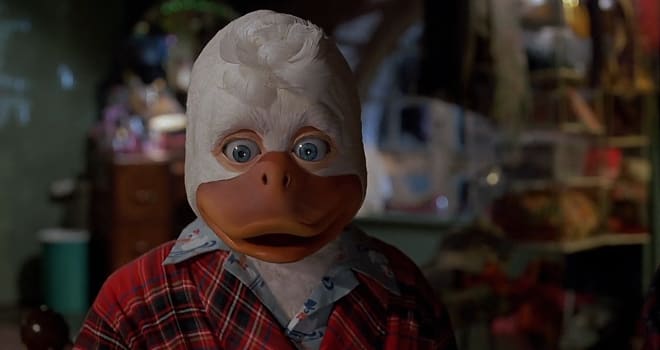 16. One last fact -- which might make you go all brainsplode. One good thing that came out of this flop? The creation of Pixar. See? Mind. Blown.
16. One last fact -- which might make you go all brainsplode. One good thing that came out of this flop? The creation of Pixar. See? Mind. Blown. Fifteen years ago,
Fifteen years ago,  1. Hathaway landed the part of Mia partly because Garry Marshall's granddaughters saw her audition tape and said she had the best "princess hair."
1. Hathaway landed the part of Mia partly because Garry Marshall's granddaughters saw her audition tape and said she had the best "princess hair." 3. Hathaway only had one audition for the film. As she told
3. Hathaway only had one audition for the film. As she told  5. Mia's cat Fat Louie? Hathaway's real-life pet (above). It had to be doubled by three different cats, one that could be carried, one that would sit perfectly still, one who could jump, and the last one who sits on the envelope at the end of the movie.
5. Mia's cat Fat Louie? Hathaway's real-life pet (above). It had to be doubled by three different cats, one that could be carried, one that would sit perfectly still, one who could jump, and the last one who sits on the envelope at the end of the movie. 7. "The Princess Diaries" is the only major role for musician
7. "The Princess Diaries" is the only major role for musician  9. Hathaway's bushy hairpiece was so unruly, it was nicknamed "The beast." And her out-of-control fake eyebrows took an hour to apply since each hair had to be individually applied.
9. Hathaway's bushy hairpiece was so unruly, it was nicknamed "The beast." And her out-of-control fake eyebrows took an hour to apply since each hair had to be individually applied. 11. "The Princess Diaries" was a family affair: The girls seeking Mia's autograph are Lilly and Charlotte, Marshall's twin granddaughters. And Clarisse's secretary Charlotte, is played by Kathleen, his daughter.
11. "The Princess Diaries" was a family affair: The girls seeking Mia's autograph are Lilly and Charlotte, Marshall's twin granddaughters. And Clarisse's secretary Charlotte, is played by Kathleen, his daughter. 13. The romance between Queen Clarisse Renaldi (Julie Andrews) and Joseph (Hector Elizondo) wasn't in the script, and the two actors improvised their dance scene.
13. The romance between Queen Clarisse Renaldi (Julie Andrews) and Joseph (Hector Elizondo) wasn't in the script, and the two actors improvised their dance scene. 15. Hathaway told HuffPost Live that "Princess Diaries" was "a great first job," but she struggled to land more serious acting gigs afterwards. "It was hard get into rooms, to be taken seriously for roles that weren't princesses."
15. Hathaway told HuffPost Live that "Princess Diaries" was "a great first job," but she struggled to land more serious acting gigs afterwards. "It was hard get into rooms, to be taken seriously for roles that weren't princesses." 17.
17. What kind of movie is "
What kind of movie is " 1. You might not think of
1. You might not think of  2. Reiner's auditions for the four leads yielded boys whose personalities matched their roles. "I was awkward and nerdy and shy and uncomfortable in my own skin and really, really sensitive," Wheaton recalled in 2011, "and River was cool and really smart and passionate and -- even at that age -- kind of like a father figure to some of us. Jerry was one of the funniest people I had ever seen in my life, either before or since, and Corey was unbelievably angry and in an incredible amount of pain and had an absolutely terrible relationship with his parents."
2. Reiner's auditions for the four leads yielded boys whose personalities matched their roles. "I was awkward and nerdy and shy and uncomfortable in my own skin and really, really sensitive," Wheaton recalled in 2011, "and River was cool and really smart and passionate and -- even at that age -- kind of like a father figure to some of us. Jerry was one of the funniest people I had ever seen in my life, either before or since, and Corey was unbelievably angry and in an incredible amount of pain and had an absolutely terrible relationship with his parents." 3. As the narrator, the adult version of Wheaton's character, Reiner cast actor
3. As the narrator, the adult version of Wheaton's character, Reiner cast actor  4. The independent studio behind the film was Embassy, owned by Reiner's "
4. The independent studio behind the film was Embassy, owned by Reiner's " 5. The boys were never really in danger during the famous train-dodge scene. Part of the scene involved stunt doubles -- women with close-cropped hair made up to look like the boys. And part of it involved an extra-long telephoto lens to make it look like the train was right behind the boys when, actually, it was still on the far side of the bridge.
5. The boys were never really in danger during the famous train-dodge scene. Part of the scene involved stunt doubles -- women with close-cropped hair made up to look like the boys. And part of it involved an extra-long telephoto lens to make it look like the train was right behind the boys when, actually, it was still on the far side of the bridge. 6. The swamp used in the leech scene was man-made, a pond dug out and filled with water by the production crew before the shoot. By the time Reiner was ready to film the scene, it was already overgrown with moss. The leeches were real.
6. The swamp used in the leech scene was man-made, a pond dug out and filled with water by the production crew before the shoot. By the time Reiner was ready to film the scene, it was already overgrown with moss. The leeches were real. 7. The four young stars got into plenty of misbehavior during their down time. Wheaton rigged the coin-operated arcade games at their hotel so that they could be played for free. Reiner says Phoenix (then 15) lost his virginity to a Phoenix family friend during a night away from the hotel. Feldman says he and Phoenix both smoked pot.
7. The four young stars got into plenty of misbehavior during their down time. Wheaton rigged the coin-operated arcade games at their hotel so that they could be played for free. Reiner says Phoenix (then 15) lost his virginity to a Phoenix family friend during a night away from the hotel. Feldman says he and Phoenix both smoked pot. 8. And
8. And 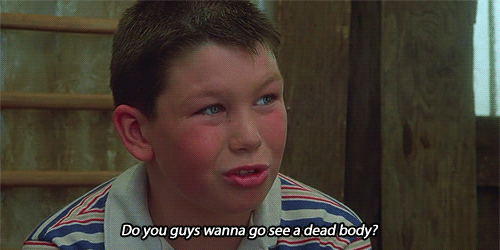 9. The movie was originally titled "The Body," after the Stephen King story it was based on. The film's marketers worried that it sounded like a horror movie, a bodybuilding film, or a porno. Reiner came up with the title "Stand by Me" based on the Ben E. King standard that he'd picked to play out over the end of the film.
9. The movie was originally titled "The Body," after the Stephen King story it was based on. The film's marketers worried that it sounded like a horror movie, a bodybuilding film, or a porno. Reiner came up with the title "Stand by Me" based on the Ben E. King standard that he'd picked to play out over the end of the film. 10. Lear's $8 million investment turned out to be a smart move. "Stand By Me" earned back $52 million at the box office.
10. Lear's $8 million investment turned out to be a smart move. "Stand By Me" earned back $52 million at the box office. 11. The movie's Maine countryside scenes were actually filmed in and around Brownsville, Oregon, where there is now a tourist center devoted to the film. Reiner named his production company Castle Rock after the movie's fictional town.
11. The movie's Maine countryside scenes were actually filmed in and around Brownsville, Oregon, where there is now a tourist center devoted to the film. Reiner named his production company Castle Rock after the movie's fictional town. 12. The "Stand by Me" screenplay was written by
12. The "Stand by Me" screenplay was written by  The best "Transformers" movie is still the first one.
The best "Transformers" movie is still the first one. 1. For an animated movie aimed at kids, "Transformers" has a crazy-high body count. This is because Hasbro wanted to clean house and introduce a new toy line to coincide with the launch of Season Three. (The movie served as a bridge between the second and third seasons.)
1. For an animated movie aimed at kids, "Transformers" has a crazy-high body count. This is because Hasbro wanted to clean house and introduce a new toy line to coincide with the launch of Season Three. (The movie served as a bridge between the second and third seasons.) 3. The debate over whether or not to kill Prime caused "steaming arguments" among the filmmakers,
3. The debate over whether or not to kill Prime caused "steaming arguments" among the filmmakers,  5. Two things that writer Friedman had to fight to get into the movie: Arcee (above), the first female Autobot, and having the Transformers interact with humans Spike and his son, Daniel.
5. Two things that writer Friedman had to fight to get into the movie: Arcee (above), the first female Autobot, and having the Transformers interact with humans Spike and his son, Daniel.  7. The Autobots' Matrix of leadership, the shiny thing Prime passes on to rookie Hot Rod (pictured), was inspired (naturally) by the Petrean Touch in Catholicism.
7. The Autobots' Matrix of leadership, the shiny thing Prime passes on to rookie Hot Rod (pictured), was inspired (naturally) by the Petrean Touch in Catholicism. 9. Welles'
9. Welles'  11.
11.  13. Friedman's least favorite? "Wheelie was a pain in the ass."
13. Friedman's least favorite? "Wheelie was a pain in the ass." 15. The movie's most iconic song is Stan Bush's "The Touch," which -- you might wanna sit down -- was originally created by Bush and 'co-writer Lenny Macaluso for
15. The movie's most iconic song is Stan Bush's "The Touch," which -- you might wanna sit down -- was originally created by Bush and 'co-writer Lenny Macaluso for  17. For the film's 20th anniversary in 2006, IDW published its own adaptation. It includes extra scenes, such as a battle between the missing combiners and Omega Supreme at the Ark, as well as Shockwave and Reflector being destroyed by Unicron.
17. For the film's 20th anniversary in 2006, IDW published its own adaptation. It includes extra scenes, such as a battle between the missing combiners and Omega Supreme at the Ark, as well as Shockwave and Reflector being destroyed by Unicron. 19. The movie takes place 20 years after the events of the series' Season 2.
19. The movie takes place 20 years after the events of the series' Season 2. 21. Unicorn in robot form originally featured more organic features. He would have rocked some serious '80s long hair in addition to a goatee and mustache. (Please let it have been a mullet!)
21. Unicorn in robot form originally featured more organic features. He would have rocked some serious '80s long hair in addition to a goatee and mustache. (Please let it have been a mullet!) Why, "
Why, "
 1. Producer
1. Producer  3. For the part of Hannibal Lecktor (yep, that's how it was spelled in the script), the producers thought of
3. For the part of Hannibal Lecktor (yep, that's how it was spelled in the script), the producers thought of  5. Noonan ultimately decided not to research any real-life serial killers to prepare for his role, but others on the set did. To learn how investigators cope with the disturbing details of such cases, Petersen consulted with the FBI Behavioral Science Unit and Chicago Police detective Charles Adamson -- the co-creator of Mann's "
5. Noonan ultimately decided not to research any real-life serial killers to prepare for his role, but others on the set did. To learn how investigators cope with the disturbing details of such cases, Petersen consulted with the FBI Behavioral Science Unit and Chicago Police detective Charles Adamson -- the co-creator of Mann's " 8. Petersen claims the scene of Graham falling asleep on a plane while examining crime scene photos had to be shot guerrilla-filmmaking style, as United Airlines had declined to give the production permission to shoot on a commercial jetliner. Mann bought coach tickets anyway on a 4 p.m. United flight from Chicago to Florida, so that there would be a sunset visible from the right side of the plane, and the crew packed their cameras and lights in their carry-on bags. (This was in the days before 9/11 and omnipresent metal detectors at airports.) They filmed the scene on the fly -- literally -- and compensated the passengers and the startled and upset flight crew for the nuisance by giving away "
8. Petersen claims the scene of Graham falling asleep on a plane while examining crime scene photos had to be shot guerrilla-filmmaking style, as United Airlines had declined to give the production permission to shoot on a commercial jetliner. Mann bought coach tickets anyway on a 4 p.m. United flight from Chicago to Florida, so that there would be a sunset visible from the right side of the plane, and the crew packed their cameras and lights in their carry-on bags. (This was in the days before 9/11 and omnipresent metal detectors at airports.) They filmed the scene on the fly -- literally -- and compensated the passengers and the startled and upset flight crew for the nuisance by giving away " 11. Like the real-life profilers Petersen had met, he couldn't shake the job at the end of the day. After "Manhunter," he went on to do a play in Chicago but kept feeling the Will Graham character coming out in his performance. He finally shaved his beard, cut his hair, and dyed it blond so he'd see a different face when he looked in the mirror.
11. Like the real-life profilers Petersen had met, he couldn't shake the job at the end of the day. After "Manhunter," he went on to do a play in Chicago but kept feeling the Will Graham character coming out in his performance. He finally shaved his beard, cut his hair, and dyed it blond so he'd see a different face when he looked in the mirror. 13. Mann hired cinematographer
13. Mann hired cinematographer  "Be afraid. Be very afraid." And we have been, for three decades, ever since the release of "
"Be afraid. Be very afraid." And we have been, for three decades, ever since the release of " 1. Comedy legend
1. Comedy legend  4. Best known at the time for playing quirky characters like the People magazine reporter in "
4. Best known at the time for playing quirky characters like the People magazine reporter in "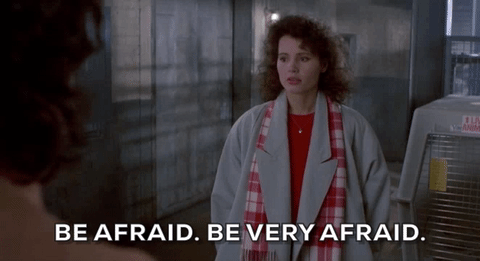 6. Indeed, Davis had started unconsciously to mimic Goldblum's movements and his distinctive, stop-start speech pattern, and Cronenberg had to coach the imitation out of her performance. Goldblum also had to avoid Davis when she shot scenes with John Getz (who played his romantic rival, Stathis) because of his real-life jealousy.
6. Indeed, Davis had started unconsciously to mimic Goldblum's movements and his distinctive, stop-start speech pattern, and Cronenberg had to coach the imitation out of her performance. Goldblum also had to avoid Davis when she shot scenes with John Getz (who played his romantic rival, Stathis) because of his real-life jealousy. 7. The name of Goldblum's character, Seth Brundle, was inspired by Formula One driver Martin Brundle. A fan of motor sports, Cronenberg often names his characters after racing-world figures. Paradoxically, Seth Brundle hates driving because he's prone to motion sickness, which is what prompts him to invent the teleportation pods in the first place.
7. The name of Goldblum's character, Seth Brundle, was inspired by Formula One driver Martin Brundle. A fan of motor sports, Cronenberg often names his characters after racing-world figures. Paradoxically, Seth Brundle hates driving because he's prone to motion sickness, which is what prompts him to invent the teleportation pods in the first place. 8. At the time of the production, Cronenberg also owned a vintage Ducati motorcycle, whose cylinders were the design inspiration for the telepods.
8. At the time of the production, Cronenberg also owned a vintage Ducati motorcycle, whose cylinders were the design inspiration for the telepods. 10. The sequence where Seth crawls on the ceiling (above) was accomplished via a set mounted on a Ferris wheel-like device. The set would rotate (with the camera fixed in place) so that Goldblum could appear to defy gravity.
10. The sequence where Seth crawls on the ceiling (above) was accomplished via a set mounted on a Ferris wheel-like device. The set would rotate (with the camera fixed in place) so that Goldblum could appear to defy gravity. 12. After Getz shot the climactic scene where the fully-transformed Brundle severs Stathis's foot by vomiting digestive enzymes on it, Getz kept the prop foot in his refrigerator.
12. After Getz shot the climactic scene where the fully-transformed Brundle severs Stathis's foot by vomiting digestive enzymes on it, Getz kept the prop foot in his refrigerator. 13. The line "Be afraid. Be very afraid," which became the movie's most famous bit of dialogue, was thought up by Brooks. It was also used on the posters and marketing for the film (above).
13. The line "Be afraid. Be very afraid," which became the movie's most famous bit of dialogue, was thought up by Brooks. It was also used on the posters and marketing for the film (above).  14. It took Goldblum up to five hours a day to bury himself under the prosthetics that transformed him into a man-sized insect, but it was worth the effort.
14. It took Goldblum up to five hours a day to bury himself under the prosthetics that transformed him into a man-sized insect, but it was worth the effort.  16. Walas also directed the 1989 sequel "
16. Walas also directed the 1989 sequel " 18. By the way, the
18. By the way, the  The new "
The new " 1. MGM first announced it was planning a remake of
1. MGM first announced it was planning a remake of  3. At first, director
3. At first, director  5. Actually, Wyler had been thinking of Heston to play the villain Messala. But when he moved into the lead, and Kirk Douglas and Stewart Granger turned down the role of Judah's Roman friend-turned-rival, it fell to Irish actor
5. Actually, Wyler had been thinking of Heston to play the villain Messala. But when he moved into the lead, and Kirk Douglas and Stewart Granger turned down the role of Judah's Roman friend-turned-rival, it fell to Irish actor  7. Out of reverence, the face of Jesus Christ is never shown on screen during "Ben-Hur," and the actor playing him is not credited in the film. It was opera singer Claude Heater, an American tenor the filmmakers had discovered during a concert in Rome.
7. Out of reverence, the face of Jesus Christ is never shown on screen during "Ben-Hur," and the actor playing him is not credited in the film. It was opera singer Claude Heater, an American tenor the filmmakers had discovered during a concert in Rome. 9. In his memoir, Heston disputed Vidal's claims and dismissed his contributions to the script. (Vidal's response to Heston's denial was, more or less, "He would, wouldn't he?") Scholars continue to argue over the claims, but watch Boyd and Heston's scenes together and decide for yourself.
9. In his memoir, Heston disputed Vidal's claims and dismissed his contributions to the script. (Vidal's response to Heston's denial was, more or less, "He would, wouldn't he?") Scholars continue to argue over the claims, but watch Boyd and Heston's scenes together and decide for yourself. 11. For the movie's centerpiece sequence, the chariot race, the producers built what was then the biggest movie set ever constructed. The arena, an accurate duplicate of an actual Roman stadium outside Jerusalem, was five stories tall and big enough to enclose a track 2000 feet long and 65 feet wide. There were actually two such tracks, one built outside of camera range for the horses and riders to train and rehearse. For the track surface, some 40,000 tons of white sand were imported from Mexico. The arena cost $1 million to build and spanned 18 acres on the Cinecittà lot.
11. For the movie's centerpiece sequence, the chariot race, the producers built what was then the biggest movie set ever constructed. The arena, an accurate duplicate of an actual Roman stadium outside Jerusalem, was five stories tall and big enough to enclose a track 2000 feet long and 65 feet wide. There were actually two such tracks, one built outside of camera range for the horses and riders to train and rehearse. For the track surface, some 40,000 tons of white sand were imported from Mexico. The arena cost $1 million to build and spanned 18 acres on the Cinecittà lot. 13. Heston and Boyd spent weeks training to steer the four-horse chariot teams; in most of the shots, that's really the two stars at the reins. In the Roman summer heat, the horses could complete only about eight laps per day, and the sequence took five weeks to shoot over the course of three months.
13. Heston and Boyd spent weeks training to steer the four-horse chariot teams; in most of the shots, that's really the two stars at the reins. In the Roman summer heat, the horses could complete only about eight laps per day, and the sequence took five weeks to shoot over the course of three months. 15. Boyd wore a steel-lined costume for the close-ups of the scene where Messala gets dragged by the chariot, but the scenes where he and other riders get trampled were all filmed using realistic dummies. Claims that a stunt man was fatally run over, or that you can see that death on screen, are
15. Boyd wore a steel-lined costume for the close-ups of the scene where Messala gets dragged by the chariot, but the scenes where he and other riders get trampled were all filmed using realistic dummies. Claims that a stunt man was fatally run over, or that you can see that death on screen, are  17. During the shoot, Boyd married Italian-born studio executive Mariella Di Sarzana. But they separated after three weeks and divorced in early 1959.
17. During the shoot, Boyd married Italian-born studio executive Mariella Di Sarzana. But they separated after three weeks and divorced in early 1959. 19. Initially budgeted at $7 million, the film's cost ballooned during the shoot to a record $15 million. That figure included about $1.1 million worth of 70mm film stock, an extra $100,000 for Wyler for assuming Zimbalist's producer duties after his death, $4 million for the chariot sequence (including $200,000 to replace two wide-screen lenses destroyed during chariot accidents), and $150,000 to dismantle the sets after the shoot ended so that other productions couldn't use them. Plus, MGM spent almost $15 million more to market the film.
19. Initially budgeted at $7 million, the film's cost ballooned during the shoot to a record $15 million. That figure included about $1.1 million worth of 70mm film stock, an extra $100,000 for Wyler for assuming Zimbalist's producer duties after his death, $4 million for the chariot sequence (including $200,000 to replace two wide-screen lenses destroyed during chariot accidents), and $150,000 to dismantle the sets after the shoot ended so that other productions couldn't use them. Plus, MGM spent almost $15 million more to market the film. 21. The epic proved an instant hit, grossing an incredible $147 million worldwide during its initial run. At the time, that made it the second-highest grossing film ever, behind only "
21. The epic proved an instant hit, grossing an incredible $147 million worldwide during its initial run. At the time, that made it the second-highest grossing film ever, behind only " 23. "Ben-Hur" won a record 11 Academy Awards, including Best Picture (making Zimbalist the only producer ever to win Oscar's top prize posthumously), Best Director (for Wyler), Best Actor (for Heston), Best Supporting Actor (for
23. "Ben-Hur" won a record 11 Academy Awards, including Best Picture (making Zimbalist the only producer ever to win Oscar's top prize posthumously), Best Director (for Wyler), Best Actor (for Heston), Best Supporting Actor (for  25. In 1972, Heston used leftover footage from the "Ben-Hur" sea battle sequence in his film version of Shakespeare's "
25. In 1972, Heston used leftover footage from the "Ben-Hur" sea battle sequence in his film version of Shakespeare's "